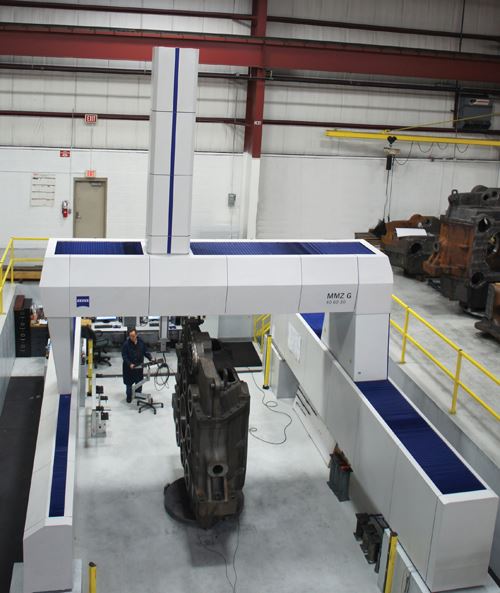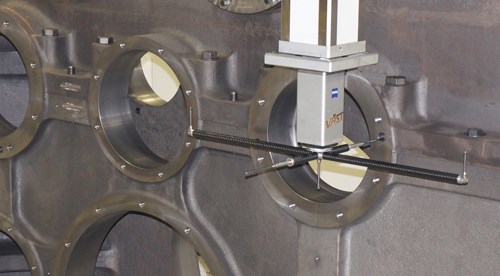By the time Three-M Tool and Machine acquired an expansion of its first wind energy contract in 2008, the Commerce Township, Michigan-based manufacturer was well-prepared to make the investments required to make an even bolder move into that growing sector. That year, the company purchased a dedicated, 43,000-square-foot facility in nearby Wixom and stocked it with machinery large enough to handle even the most massive wind turbine components. Among that equipment were four large horizontal boring mills from MAG Giddings & Lewis (Fond du Lac, Wisconsin) as well as what metrology equipment supplier Carl Zeiss (Maple Grove, Minnesota) says is its only CMM in the Western Hemisphere capable of measuring 3 meters vertically. These machines proved critical not only for meeting the needs of that first contract, but also for attracting additional work.
The initial contract involved machining large gearbox housings and forward housings for California-based wind turbine manufacturer Clipper Windpower. Standing 10 feet tall and weighing tens of thousands of pounds, these housings consist of three separate iron castings. The first production step is rough-machining each casting as a separate piece. However, only the mating surfaces are finish-machined at this stage. This ensures the castings will fit together for the final machining step, in which the last 0.7 mm of material is removed from the assembled housing.
Leaving that small amount of stock on critical faces and bores is important to prevent the parts from warping out of shape, explains Michael Medwid, company president. The casting process can introduce microscopic stresses in the material that can be released by machining and cause the part to warp—a phenomenon that is especially problematic with large parts that require removing a large amount of material. At Three-M, assembling the large wind turbine housings before finish-machining allows these stresses to relieve without throwing off the precise alignment between the castings, which could create problems during final assembly at the customer’s facility. “Most of the bores are split between the castings, with half on one piece and half on the other. The tolerances are just too tight to finish the parts in the unassembled state,” Mr. Medwid says.
However, prior to the company’s investment in large-part manufacturing capabilities, the assembled housings simply wouldn’t fit within the workzones of any of its machining or measuring equipment. The only option was assembling two of the three castings for machining and final inspection. Then, it would remove one of those castings from the assembly, attach the third, and repeat the process. “We had to move the parts on and off both the boring mill and the CMM every time,” Mr. Medwid recalls. “On top of that, we had to lay the part down for the CMM and stand it back up again for the boring mill. It was a real mess.”
That process had been a sufficient work-around when the contract called for only a few housings per month, but the newly expanded contract required 16. On the machining side, the company determined that one PT 1800 and three RT1600 horizontal boring mills from MAG Giddings & Lewis could provide the required size and capabilities. The PT1800 features X-, Y-, W- and Z-axis travels of 3,600 by 3,600 by 2,000 by 1,250 mm, respectively, along with an 1,800- by 3,600-mm table surface. The RT1600s are slightly smaller, with the same X- and Y-axis travels but only 1,500 and 1,250 mm in the W and Z axes. All the machines also offer 25,000-mm-per-minute rapids, 120-position tool changers, 1 to 3,500 rpm spindle speeds and 7,500 Nm of constant torque.
The MMZ-G gantry CMM also proved well-suited for measuring the fully assembled gearbox housings. The machine can measure 3 meters vertically, leaving plenty of space to stand the housings upright, as well as 4 meters in X and 6 meters in Y. Its Vast gold probe enables scanning with styli as long as 800 millimeters and as heavy as 600 grams, enabling the company to measure deep into the forward housings. Additionally, the probe is capable of speeds ranging to 300 points per second, and it features collision protection for all directions of motion.
Mike Gray, quality manager at Three-M, says he appreciates the machine’s Calypso software because it simplifies programming. “In one window, you are able to check and change probes, clearance groups, retract distances and many other settings,” he says. “The ability to change settings on whole groups of features at once saves time and helps check the program for any errors before ever even having a part on the machine.”
The company had its eye on more than just one contract when it invested in the new equipment, and in the years since, that investment has paid off, Mr. Medwid says. He recalls one instance in 2010 when two employees from ZF Industries visited the shop to review its capabilities for producing gearbox housing prototypes. “After two hours they called their boss and said to quit looking because they had found their new supplier,” he says. “I believe that having the Zeiss CMM gave them the confidence in our commitment to quality, and along with our new G&L machines, our processing, and our ability to build our own fixtures, that won the business.”











.png;maxWidth=300;quality=90)













